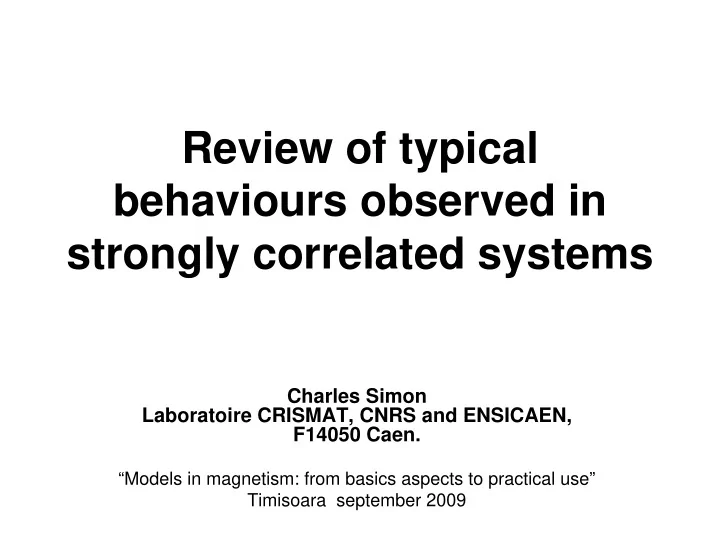

Review of typical behaviours observed in strongly correlated systems Charles Simon Laboratoire CRISMAT, CNRS and ENSICAEN, F14050 Caen. “Models in magnetism: from basics aspects to practical use” Timisoara september 2009
Some examples of strongly correlated electrons • Superconductivity • Magnetism • Low dimensionnality • Heavy fermions • Mott insulators models in magnetism timisoara 2
Free electrons 25 20 E F 15 10 5 0 -4 -2 0 2 4 x K Temperature effects (E F =1eV = 30 000K) Band structure (tight binding calculations) models in magnetism timisoara 3
Effect of electron electron repulsion U From T. Giamarchi models in magnetism timisoara 4
Not so strong Effect of correlations Broadening models in magnetism timisoara 5
6 Photoemission models in magnetism timisoara
Photoemission in insulators Hubbard satellite U models in magnetism timisoara 7
Strongly correlated metal Peak of quasi particules Hubbard peak models in magnetism timisoara 8
Transport properties • Specific heat Cp: • Sommerfeld expansion: models in magnetism timisoara 9
10 Heavy fermions models in magnetism timisoara
Band mass and effective mass models in magnetism timisoara 11
De Haas Van Alphen effect • In presence of magnetic field, it appears oscillations periodic in 1/H related to the extremum area of the Fermi surface. • In addition, there is a magnetic field dependence of the amplitude related to effective mass. (high mass, high field). models in magnetism timisoara 12
13 models in magnetism timisoara From JP Brison
Resistivity in T 2 The prefactor A scales with γ 2 condcutivity=ne 2 τ /m Also magnetic susceptibility is Cte From R. Fresard models in magnetism timisoara 14
Thermoelectric power S S= k/e π 2 /2 T/T F (1 + 2/3 z) From Behnia et al. models in magnetism timisoara 15
16 models in magnetism timisoara
Why oxides ? • Metal U/t small, no correlations, screening of interactions by excitations electron-hole • Oxides Effective t can be small U/t large models in magnetism timisoara 17
Oxides are interesting models in magnetism timisoara 18
Mott insulators V 2 O 3 models in magnetism timisoara 19
Mott insulators V 2 O 3 models in magnetism timisoara 20
21 models in magnetism timisoara
Organic conductor from Limelette et al. Transfer of the spectral weight models in magnetism timisoara 22
23 models in magnetism timisoara
24 Kondo effect models in magnetism timisoara
Kondo effect Magnetic impurities models in magnetism timisoara 25
DMFT • Dynamical mean field theory • To put together quasiparticules and Hubbard states • Limit: no Q dependence, cluster DMFT… models in magnetism timisoara 26
27 models in magnetism timisoara From A. Georges
Cobaltates Ca 3 Co 4 O 9 From Limelette models in magnetism timisoara 28
29 Specific heat models in magnetism timisoara
30 Nickelates RNiO 3 models in magnetism timisoara
Cuprates • They are high Tc superconducting materials Two different scales of energies models in magnetism timisoara 31
Overdoped cuprate: normal Fermi liquid models in magnetism timisoara 32
33 From B. Vignolle models in magnetism timisoara
YBaCuO underdoped YBa 2 Cu 3 O 6.5 (p = 0.1) A= 5.1 nm -2 = 1.9 % of the carriers Fermi arcs Abnormal photoemission models in magnetism timisoara 34
Fermi surface reconstruction: small pockets models in magnetism timisoara 35
36 models in magnetism timisoara
37 models in magnetism timisoara
Other interpretation: stripes models in magnetism timisoara 38
39 models in magnetism timisoara Cuprates
Manganites Pr 0.7 Ca 0.3 MnO 3 Electronic phase separation ? ? 4 4 30K 30K M ( μ B /f.u.) M ( μ B /f.u.) 3 3 2 2 1 1 0 0 1 1 0 0 10 10 ISOLANT ISOLANT 7 7 R ( Ω ) R ( Ω ) 10 10 METAL METAL 4 4 10 10 1 1 10 10 10 - 10 - 2 2 Jahn Teller effect = orbital ordering 0 0 2 2 4 4 6 6 8 8 10 10 B (T) B (T) Colossal magnetoresistance models in magnetism timisoara 40
From C. Martin From D. Saurel 4 10 30K -1 ) -4 Q Intensity (cm 2 10 2T -2 Q 0 10 4T -3 -2 -1 10 10 10 Q (Å) 0.6 0.6 H S H S H I-M H I-M A nano (a.u.) A nano (a.u.) 0.4 0.4 -1 ) -1 ) S/V ( μ m S/V ( μ m 0.2 0.2 0.0 0.0 2 2 3 3 4 4 5 5 6 6 7 7 Magnetic field (T) Magnetic field (T) From R. Sopracase models in magnetism timisoara 41
Conclusions • Effects of correlations: Fermi surface, effective mass, … – Specific heat, conductivity, magnetic susceptibility, photoemission and dHvA effects • Mott transition, Kondo effects – Phase separation, transfer of spectral weight • Effects of low dimensions models in magnetism timisoara 42
Recommend
More recommend